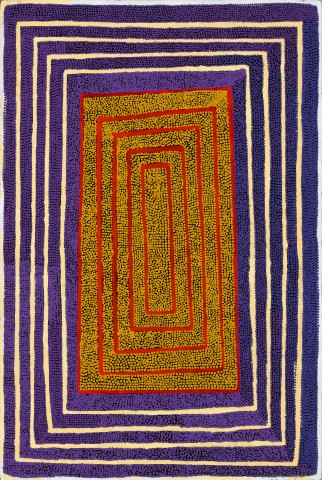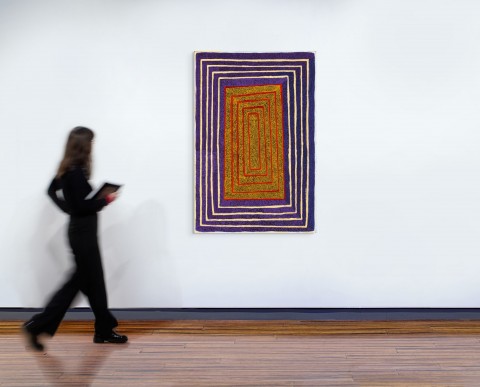KURURRUNGKA, 2001
BOXER MILNER TJAMPITJIN
synthetic polymer paint on linen
150.0 x 100.0 cm
bears inscription verso: artist's name, size and Warlayirti Artists cat. 43/01
Warlayirti Artists, Balgo Hills, Western Australia
Palya Art, Darwin
Private collection, Melbourne, acquired from the above in 2001
Purkitji (Sturt Creek), 2001, synthetic polymer paint on linen, 180.0 x 120.0 cm, in the collection of Fiona Brockhoff, illus. in Carty, J., Balgo: Creating Country, UWA Press, Crawley, 2021, p. 247
This work is accompanied by a certificate of authenticity from Warlayirti Artists which states:
‘Kururrungku is the community where Boxer presently lives, west of Balgo at the top of the Canning Stock Route in WA. This painting represents both the place and land of Kururrungku “this is the ground where we stop here”. Boxer’s use of colours represents the vegetation and bushes in the late dry and early wet season.’
Boxer Milner’s paintings of water, storms, rain, flowing rivers and floods are unique in the canon of Balgo art. Born on banks of a river in the 1930s, he spent much of his life as a stockman on Sturt Creek Station and indeed, it was only when he was too old to continue that life that he took up painting. While other Balgo artists were painting rock holes and water sources found underground, Boxer was painting water coming from the sky and flowing across the landscape. ‘He was painting the force of water, not its eternal qualities but its transformative ones – the way it shapes the land and the people who belong to it.’1 Boxer painted mostly Purkitji, the flood plain that extends out from Sturt Creek, and Walyarra, the flooding, but also other watery sites such as Lake Gregory and the rivers and tributaries that emerge after rain.
A renowned colourist, he shunned the traditional ochres and desert palette, instead mixing multiple shades of pink, blue, yellow, green and purple applied to the canvas in fields of intense close dotting. His painting often features extensive areas of white used either to highlight a dominant motif or as a way to reinforce the design. His works are idiosyncratic yet founded in tradition, as John Carty notes: ‘…The forms in Boxer’s paintings are the relationship between tradition and innovation, between memory and landscape and between self and world.’2
1. Carty, J., Balgo: Creating Country, University of Western Australia Press, Crawley, 2021, p. 249
2. ibid., p. 257
CRISPIN GUTTERIDGE

